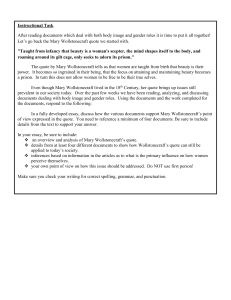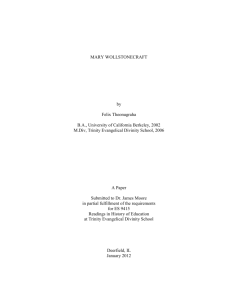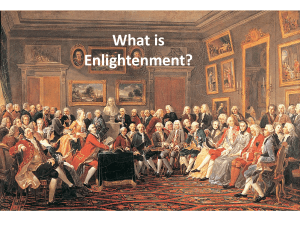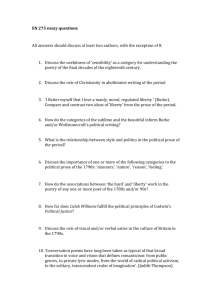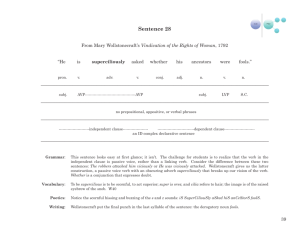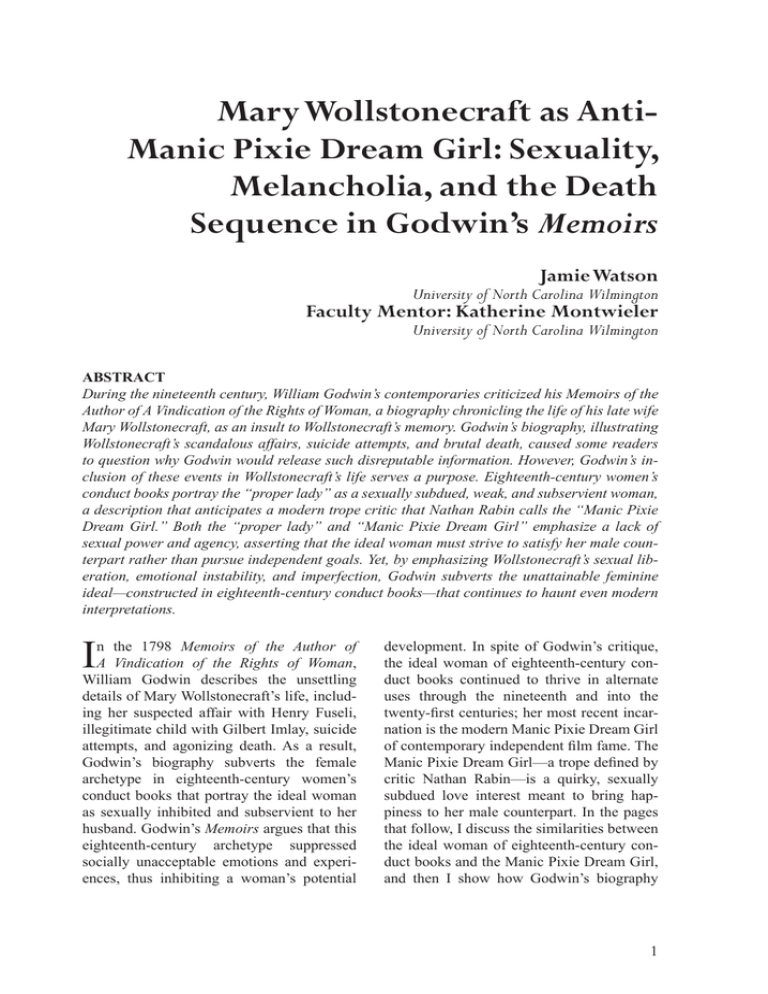
Mary Wollstonecraft as AntiManic Pixie Dream Girl: Sexuality,
Melancholia, and the Death
Sequence in Godwin’s Memoirs
Jamie Watson
University of North Carolina Wilmington
Faculty Mentor: Katherine Montwieler
University of North Carolina Wilmington
ABSTRACT
During the nineteenth century, William Godwin’s contemporaries criticized his Memoirs of the
Author of A Vindication of the Rights of Woman, a biography chronicling the life of his late wife
Mary Wollstonecraft, as an insult to Wollstonecraft’s memory. Godwin’s biography, illustrating
Wollstonecraft’s scandalous affairs, suicide attempts, and brutal death, caused some readers
to question why Godwin would release such disreputable information. However, Godwin’s inclusion of these events in Wollstonecraft’s life serves a purpose. Eighteenth-century women’s
conduct books portray the “proper lady” as a sexually subdued, weak, and subservient woman,
a description that anticipates a modern trope critic that Nathan Rabin calls the “Manic Pixie
Dream Girl.” Both the “proper lady” and “Manic Pixie Dream Girl” emphasize a lack of
sexual power and agency, asserting that the ideal woman must strive to satisfy her male counterpart rather than pursue independent goals. Yet, by emphasizing Wollstonecraft’s sexual liberation, emotional instability, and imperfection, Godwin subverts the unattainable feminine
ideal—constructed in eighteenth-century conduct books—that continues to haunt even modern
interpretations.
I
n the 1798 Memoirs of the Author of
A Vindication of the Rights of Woman,
William Godwin describes the unsettling
details of Mary Wollstonecraft’s life, including her suspected affair with Henry Fuseli,
illegitimate child with Gilbert Imlay, suicide
attempts, and agonizing death. As a result,
Godwin’s biography subverts the female
archetype in eighteenth-century women’s
conduct books that portray the ideal woman
as sexually inhibited and subservient to her
husband. Godwin’s Memoirs argues that this
eighteenth-century archetype suppressed
socially unacceptable emotions and experiences, thus inhibiting a woman’s potential
development. In spite of Godwin’s critique,
the ideal woman of eighteenth-century conduct books continued to thrive in alternate
uses through the nineteenth and into the
twenty-first centuries; her most recent incarnation is the modern Manic Pixie Dream Girl
of contemporary independent film fame. The
Manic Pixie Dream Girl—a trope defined by
critic Nathan Rabin—is a quirky, sexually
subdued love interest meant to bring happiness to her male counterpart. In the pages
that follow, I discuss the similarities between
the ideal woman of eighteenth-century conduct books and the Manic Pixie Dream Girl,
and then I show how Godwin’s biography
1
Explorations |Humanities and Fine Arts
seeks to combat this surprisingly perennial,
eighteenth-century trope. I focus on these
two constructions of femininity to show that,
despite the feminist movement and the rise
in women’s rights during the past three centuries, seemingly antiquated tropes of ideal
femininity still influence modern culture.
During Godwin’s time, portrayals of
women in conduct books encouraged women
to be “self-regulating by recognizing their
‘natural’ predispositions for both good and
evil”—nurturing goodness and suppressing evil. The virtuous, proper woman was
expected to hide flaws (Darby 336). Mary
Poovey explains that these conduct books
urged women to relinquish “appetites of
any kind” and possess “no vanity, no passion, [and] no assertive ‘self’ at all” (21). If
ideal women were supposed to be passive
and unseen, prostitutes merited an altogether
different femininity as Daniel Defoe’s Some
Considerations Upon Street-Walkers. With A
Proposal for Lessening the Present Number
of Them indicates. Published in 1726,
Defoe’s work emphasizes the difference between “good” women and prostitutes:
The great Use of Women in a Community, is
to supply it with Members that may be serviceable, and keep up a Succession. They
are also useful in another Degree, to wit, in
the Labour they make take for themselves,
or the Assistance which they may afford
their Husbands or Parents. It will readily
be allowed that a Street-walking Whore can
never answer either of these Ends; Riot and
Diseases prevent one, and the Idleness which
directs her to this Course of Life incapacitates her for the other. (6)
Defoe describes the proper woman and
streetwalker as polar opposites: the lady upholding the community through her devotion
to service and family, and the streetwalker
plaguing the community with her supposed
disease and idleness. Defoe asserts that feminine sexuality outside the confines of service
to the husband is akin to the streetwalker
tainting civilized society. The ideal woman
lives for others rather than for herself. For
2
Defoe, the eighteenth-century ideal woman
lacks individuality, sexual desires, and qualities that might evoke controversy, which are
expectations realized in the modern Manic
Pixie Dream Girl trope.
Film critic Nathan Rabin coined the term
“Manic Pixie Dream Girl” (MPDG) in his
2007 review of Elizabethtown: “The Manic
Pixie Dream Girl exists solely in the fevered
imaginations of sensitive writer-directors to
teach broodingly soulful young men to embrace life and its infinite mysteries and adventures.” Elizabethtown’s MPDG is Claire,
who exhibits her complete devotion to
Drew—the brooding male lead—by “keeping [him] awake and giddy during an allnight cell-phone verbal duet” and “sending
him on an intricately mapped-out road trip”
(Rabin 4). The model Manic Pixie Dream
Girl, Claire is a stock female character whose
sole purpose is to help the male protagonist
find himself. Throughout the film, Claire tries
to assist Drew with platitudes like “You want
to be really great? Then have the courage to
fail big and stick around. Make ‘em wonder
why you’re still smiling. That’s true greatness
to me. But don’t listen to me, I’m a Claire.”
Vaguely self-deprecating, charismatic, and
concerned with helping her brooding male,
Claire lacks personal identity, goals, and sexual desires
An earlier example of the Manic Pixie
Dream Girl is Holly Golightly from the film
Breakfast at Tiffany’s (1961). According
to film critics Rabin, Noel Murray, Amelie
Gillette, Donna Bowman, Steven Hyden, and
Leonard Pierce, in Truman Capote’s 1958
novel, Holly Golightly is a “sexually adventurous woman who jumps from man to man,
living off the gifts she extorts from them,
and changing casually with the seasons.”
The film adaptation, unlike Capote’s novel,
captures the Manic Pixie ideal. Film Holly is
“a chaste party girl who shares her opinions
easily, but keeps her affections to herself (and
her cat).” Holly’s virginal innocence “charms
writer George Peppard to such an extent that
he’s able to give up the rich older woman who
helps subsidize his work, and instead offer
Jamie Watson
his devotion to his erratic dream woman…”
(Rabin et al.). The fictional, romantic success of Hepburn’s Holly Golightly suggests
the Manic Pixie is endearing. Although the
Manic Pixie Dream Girl may seem to be a
harmless, fictional model, feminist critics
Michelle Orange and Laurie Penny fear that
she is destructive to real women.
In This is Running for Your Life, Orange
devotes a chapter solely to analyzing the
MPDG, which she calls “the banal absence—
of stability, of ambition, of selfhood, of sexual threat, of skirts that pass midthigh” and
a “fun-house reflection of millennial masculinity in crisis” (Orange 50). The Manic
Pixie Dream Girl suppresses feminine power
by glorifying the overly-simplistic woman
meant to help the brooding male discover his
identity. The trope deprives the woman of
self-perpetuating motivations and reinforces
compulsory, conventional femininity à la
Holly Golightly. I concur with Orange that
the MPDG is more than a whimsical, recurring trope and is actually a reductive model
of femininity.
In her article “I Was a Manic Pixie Dream
Girl,” Laurie Penny claims the ideal has
practical consequences because “fiction creates real life,” and “[w]omen behave in ways
that they find sanctioned in stories written
by men” (Penny). If the Manic Pixie Dream
Girl continues as an ideal female archetype,
Penny fears young girls will be driven to enact the trope—suppressing identity, sexuality,
and personal objectives.
Recently, Rabin apologized for “coining
the phrase ‘Manic Pixie Dream Girl,’” saying he “created the phrase to call out cultural
sexism and to make it harder for male writers
to posit reductive, condescending male fantasies of ideal women as realistic characters.”
Rabin challenges writers to “create better,
more nuanced and multidimensional female
characters” with “complicated emotions and
total autonomy”(“I’m sorry for coining the
phrase ‘Manic Pixie Dream Girl.’”). Rabin’s
solution—that the trope should be eliminated
from discourse—fails to acknowledge that
discussion of the term has created awareness
and criticism of such patriarchal standards
of femininity. As demonstrated by the eighteenth-century proper lady, the idealization
of submissive women did not begin with the
Manic Pixie, and its increased prevalence in
cultural discussion is not an indulgence in the
trope. Indeed, one should look to and at the
stereotype, its history, and its implications.
Laurie Penny suggests another answer to
the question about the trope’s enduring popularity, calling for the “opening of space in
the collective imagination for women who
have not been permitted such space before,
for women who don’t exist to please, to delight, to attract men, for women who have
more on our minds” (Penny). Her solution
to the Manic Pixie trope recalls Godwin’s
portrayal of Wollstonecraft, which focuses
on his wife’s “sexual relationships, suicide attempts, and other unorthodox life
choices” (Monsam 127). However, critics
of Memoirs, at the time it was published,
viewed Godwin’s biography as offensive to
Wollstonecraft’s memory.
Early critics of Godwin’s Memoirs questioned the writer’s motivation for portraying
his wife as sexually deviant and depressed.
Mitzi Myers writes,
Many who admired Wollstonecraft were also
offended and, like some modern biographers,
puzzled at Godwin’s motivation for such candor. [Robert] Southey expressed his disgust
at Godwin’s “want of all feeling in stripping
his dead wife naked,” and another friend
jotted verses which conclude, “mourn’d by
Godwin with a heart of stone.” (Myers 302)
Critics like Southey rejected Godwin’s account of Wollstonecraft’s personal traumas and failings. But, Godwin emphasizes
Wollstonecraft’s sexuality and intimate relationships, illustrates her melancholia, and
depicts her death in great detail to portray
his wife as a woman who transcends the reductive and anti-feminist ideals of the eighteenth-century equivalent of the Manic Pixie
Dream Girl.
3
Explorations |Humanities and Fine Arts
Wollstonecraft’s Intimate Relationships
Godwin’s intention for including his
wife’s scandalous sexual history while relaying little of his own intimate relations
with Wollstonecraft warrants suspicion. Yet
Godwin’s articulation of Wollstonecraft’s
relationships demonstrates how he views
her suspected affair with the married Henry
Fuseli and conception of an illegitimate
child as vital to her self-defined identity.
These experiences foster intellectualism,
sensibility, and one of her greatest obstacles:
melancholia.
In Memoirs, one of Wollstonecraft’s first
romantic interests is Henry Fuseli, the celebrated painter. Wollstonecraft, being a
“person perhaps more susceptible of the
emotions painting is calculated to excite,”
indulges in an emotionally complex relationship with Fuseli, a married man. Godwin
notes, “It cannot be doubted, but that this
was the species of exercise very conducive
to the improvement of Mary’s mind” (77).
Godwin’s most obvious goal in underscoring
Wollstonecraft’s relationship with Fuseli is
demonstrating her need for self-improvement
and self-education. But Wollstonecraft and
Fuseli’s relationship, according to Godwin,
degrades as it moves transitions from platonic to romantic.
Godwin concedes that Fuseli and
Wollstonecraft’s
initial
companionship
is platonic and, rather than defending
Wollstonecraft from accusations of promiscuity, reaffirms Wollstonecraft’s self-perpetuating motive to improve her mind and appreciation of the aesthetic. Godwin writes that “if
Mr. Fuseli had been disengaged at the period
of their acquaintance, he would have been the
man of her choice” and that Wollstonecraft
“conceived it both practicable and eligible, to
cultivate a distinguishing affection for him…
without departing in the smallest degree from
the rules she prescribed to herself” (79).
Godwin reiterates Wollstonecraft’s motivation to improve herself and her situation by
cultivating a relationship with Fuseli, taking
the initiative to educate herself by way of his
4
presence. Godwin also lingers on this aspect
of Fuseli and Wollstonecraft’s relationship,
rather than on their romantic relationship, to
show Wollstonecraft’s prioritizing of intellectualism and artistic sensibility over mere affection, though she gained both from Fuseli.
Godwin interrupts his telling of
Wollstonecraft’s relations with Fuseli to acknowledge the first time that he, her future
husband, meets Wollstonecraft. At a dinner party with Thomas Paine, Godwin and
Wollstonecraft leave “mutually displeased
with each other” (81). This non-romantic
encounter helps to legitimize Godwin as an
unbiased writer of Wollstonecraft’s biography. One might assume Wollstonecraft’s
future husband would hyper-romanticize
this moment between them, implying their
love is pre-destined. However, Godwin does
the opposite. He writes about this instance
frankly, revealing his initial disinterest in
Wollstonecraft and his annoyance with her.
By conveying their first encounter with almost brutal honesty, Godwin establishes
himself as a reliable narrator rather than as
a man acknowledging the wrongs that other
men do to his beloved wife. Additionally,
Godwin’s rational rather than romantic views
toward his Wollstonecraft’s love interests reflect his equally rational view of marriage. In
Political Justice, Godwin describes marriage
as a “legal institution and social practice”
that “presupposes mutual understanding between husband and wife for life, and is entered following a romantic, usually deceptive, decision based on inexperience” (Pérez
219). This analytical opinion of marriage
permeates Godwin’s biography as he dissects
events with candid storytelling.
Godwin explains that Wollstonecraft’s
return to France to visit Fuseli is not due to
“a Platonic affection” but to enjoy “pleasure
in his society” and Wollstonecraft’s “ardent
imagination was continually conjuring up
pictures of the happiness she should have
found.” Her relationship with Fuseli then becomes a “perpetual torment to her” (81). By
writing of Wollstonecraft’s desire for Fuseli,
Godwin acknowledges the whole woman as
Jamie Watson
an adult with complex feelings. Emphasizing
Wollstonecraft’s ability to overcome her desire, Godwin demonstrates how she acquires
agency from her failed pursuit of Fuseli.
However, Wollstonecraft only grows melancholic following her next relationship with
Gilbert Imlay.
Another controversy addressed by Godwin is Wollstonecraft’s cohabitation with
Imlay and illegitimate child. A skeptical
reader might question Godwin’s intent for
emphasizing this relationship. But I believe
that Godwin, by including Wollstonecraft’s
relationship with Imlay, reiterates how her
sexuality, motherly capabilities, and melancholia result from her lived experiences.
Because both the eighteenth-century
proper lady and the Manic Pixie Dream
Girl ideal are defined by their virginal qualities—encapsulated by the virtuous and pure
Holly Golightly from the film Breakfast at
Tiffany’s—Wollstonecraft’s sexual activity still may surprise some readers expecting a conventional heroine. For Godwin,
Wollstonecraft is a woman, not a dream girl.
Her very identity, strength, and wisdom demand sexual experience. Godwin chooses to
acknowledge Wollstonecraft’s sexuality and
romantic partners in terms of how they help
her discover and better herself. Wollstonecraft
grows as an intellectual as a result of failed
romances, one of the most prominent being
her permanent separation from Gilbert Imlay.
The end of Wollstonecraft’s intimate relationship with Imlay catalyzes her “desperate purpose to die”—beginning her battle
with melancholia, which the Oxford English
Dictionary (OED) defines as “severe endogenous depression, with loss of interest and
pleasure in normal activities, disturbance of
sleep and appetite, feelings of worthlessness
and guilt, and thoughts of death or suicide”
(“melancholia”). But, Godwin notes, this
is not due to Wollstonecraft’s dependence
on Imlay. He writes, “While she was absent from Mr. Imlay, she could talk of purposes of separation and independence” (93).
Overwhelmed by his presence, her ideas of
independence are suppressed. Wollstonecraft
is then not a one-dimensional and needy
woman. Instead, Wollstonecraft’s residual
feelings of unrequited love for Fuseli and
Imlay build and are released in the form of
melancholia.
Wollstonecraft’s Melancholia
In Memoirs, William Godwin continues his
seemingly unflattering portrayal of his late
wife by illustrating Wollstonecraft’s battle
with melancholia and her subsequent suicide
attempts. Instead of perceiving this depressive
state as tarnishing her reputation or as an unveiling of precious, personal issues, Godwin
utilizes the melancholia to illustrate why he
fell in love with Wollstonecraft; he reads her
prose and is inspired by the intellectualism
and sensibility she displays in her relationships with Fuseli and Imlay. Wollstonecraft’s
experiences with melancholia and her ability to learn from them distinguish her from
the eighteenth-century conduct books’ ideal
woman and the contemporary Manic Pixie
Dream Girl.
In Letters Written during a Short
Residence in Sweden, Norway, and Denmark,
Wollstonecraft describes the landscape as the
cure for depression:
I was alone, till some involuntary sympathetic emotion…made me feel that I was still a part of a mighty whole, from which I
could not sever myself—not, perhaps, for the
reflection has been carried very far, by snapping the thread of an existence which loses
its charms in proportion as the cruel experience of life stops or poisons the current of the
heart. (17)
The “beauty of the northern summer’s evening and night” evoke in her an “involuntary
sympathetic emotion,” suggesting travel and
the landscape help heal her melancholic, suicidal tendencies (16). Wollstonecraft articulates that it is not other people who ultimately
heal her; instead, she is saved by the absence
of others, the powers of the picturesque landscape, and the pursuit of self-identification.
5
Explorations |Humanities and Fine Arts
It is Letters that finally attracts Godwin to
Wollstonecraft, showing his affinity for
the independent, sensitive, and intelligent
female.
Godwin explains that he falls in love with
Wollstonecraft, not because she is virginal
or manic but rather because she is melancholic. In Memoirs, Godwin describes
Wollstonecraft’s Letters Written during a
Short Residence in Sweden, Norway, and
Denmark:
If ever there was a book calculated to make
a man in love with its author, this appears to
me to be the book. She speaks of her sorrows,
in a way that fills us with melancholy, and
dissolves us in tenderness, at the same time
that she displays a genius which commands
all our admiration. (95)
Godwin stresses Wollstonecraft’s sensibility,
power, and intelligence—“a genius which
commands all our admiration.” Instead of
criticizing her melancholic experience, he
describes it as a commendable trait and a sign
of intelligence. It is also surprising that, in
Memoirs, Godwin does not characterize traditional expectations of eighteenth-century
women as solely feminine, as medical experts of Godwin’s time believed that possessing sensibility and intellectualism resulted in
male melancholia (95).
In eighteenth-century Britain, medical experts believed melancholia resulted from the
“coexistence of great rational intelligence and
refined sensibility”—rationality being innate
to men and sensibility naturally instilled in
women. Even success in the literary field was
“associated with male melancholia” (Kautz
38). Godwin elaborates on Wollstonecraft’s
melancholia and intelligence, expressing
her power to transcend the arbitrary confines of gender and medical categorization
established by physician and writer William
Buchan.
Buchan, in his 1769 health guide Domestic
Medicine, “associates melancholia with men
and masculine activities, and hysteria with
women and feminine activities” (38). The
OED defines “hysteria” as “a functional
6
disturbance of the nervous system…usually
attended with emotional disturbances and
enfeeblement or perversion of the moral and
intellectual faculties” (“hysteria”). Hysteria
is characterized by compromised intelligence
and overwhelming sensibility; Godwin asserts that Wollstonecraft’s strength is her
ability to overcome such obstacles and to attain both intelligence and sensibility.
Explaining his intentions for including
Wollstonecraft’s melancholic travels in
Memoirs, Godwin writes, “Depicting her
intelligent and perceptive interactions with
the landscape is one way about making her
mind’s functioning visible.” He also underscores the “great emotive and mental capabilities that [Wollstonecraft] possessed” (39).
By continuing to note Wollstonecraft’s intelligence and sensibility, Godwin establishes
Wollstonecraft as exceeding the confines of
traditional gender stereotypes.
Godwin’s candid portrayal of Mary
Wollstonecraft’s melancholia and suicidal
tendencies proved abusive to her reputation.
According to Ildiko Csengei, “After the publication of the Memoirs, Wollstonecraft’s
work was largely ignored and her name only
invoked as a warning until the end of the following century. Her reputation suffered intensely from what the public saw as tasteless
exposure” (492).Yet Godwin was trying to
liberate Wollstonecraft; in Memoirs, he emphasizes intellectualism and the female capability to experience melancholia instead of
hysteria to challenge the reductive perception
of female intellect. Godwin’s Wollstonecraft
is capable of both stereotypical feminine
sensibility and male intellectualism, though
admittedly, he romanticizes the notion of the
empowered woman of influence and education who is still tender-hearted. Godwin also
stresses Wollstonecraft’s depression to show
how she overcomes such severe emotions
through her observations and writings.
Throughout Memoirs, Godwin emphasizes Wollstonecraft’s ability to conquer
obstacles. Unlike her “timid and irresolute” friend Fanny Blood, Godwin says
Wollstonecraft has a “firmness of mind, an
Jamie Watson
unconquerable greatness of soul, by which,
after a short internal struggle, she was accustomed to rise above difficulties and suffering” (58). Acknowledging Wollstonecraft’s
ability to overcome melancholia as a sign of
strength, Godwin strives to deter criticism of
Wollstonecraft for her suicidal tendencies and
depression—qualities considered undignified
and irresponsible for a mother. Much like his
detailed description of Wollstonecraft’s relationships, Godwin utilizes the controversial
to emphasize Wollstonecraft’s growth as a
result of her lived experiences.
Wollstonecraft’s melancholic representation contrasts with the Manic Pixie Dream
Girl because the Manic Pixie Dream Girl is
first and foremost characterized as “manic.”
The OED defines “mania” as “madness,
particularly of a kind characterized by uncontrolled, excited, or aggressive behavior
[frequently] contrasted with melancholia”
(“mania”). Just as Buchan establishes hysteria as feminine, Jordynn Jack emphasizes
how mania is innately feminine in her analysis of the Manic Pixie Dream Girl.
Jack’s 2012 study explores how women
with autism adopt non-normative gender
identities to cope with mental illness. In
the study, one woman in particular, Vivian,
adopts the characteristics of the Manic Pixie
Dream Girl as a coping mechanism for her
Asperger’s syndrome. Jack’s study exemplifies how the Manic Pixie Dream Girl exists
outside of fiction.
This role does not seem like one Vivian has
“made up” out of nowhere; instead, it seems
to be an amalgam of her observations of others (in life and in film), and of the expectations required of women in different social
situations. Her language shows that she does
not view her chosen role fully as embodied,
a product of repeated stylized acts that she
has imbibed since childhood. Instead, she
views Manic Pixie Dream Girl much more
as a performance, a rhetorical device and a
coping mechanism: Manic Pixie Dream Girl
offers “the only acceptable way for a girl to
be weird” and “the only way of synthesizing
my AS [Asperger’s syndrome] into a reasonably acceptable personality. (11)
This performance of Manic Pixie Dream
Girl characteristics by a mentally-impaired
woman exhibits the possible real-life consequences of the trope. As Penny asserts, the
trope exists in the real world because “fiction creates real life.” Vivian’s decision to
perform the role of the Manic Pixie Dream
Girl demonstrates her need to be socially acceptable by resembling the feminine ideal.
Just as nineteenth-century critics viewed
Godwin’s portrayal of Wollstonecraft’s own
struggles with mental illness as insulting,
Vivian fears the same kind of critical judgment. The Manic Pixie Dream Girl trope becomes a coping mechanism to hide Vivian’s
Asperger’s. As Jack reveals with this study,
the mania of the Manic Pixie Dream Girl that
Vivian adopts works to reinforce the traditional gender expectations that Godwin’s portrayal of Wollstonecraft attempts to subvert.
Because she rejects feminized hysteria
and opts for bouts of melancholia and happiness, Wollstonecraft becomess more than a
one-dimensional woman defined by her mental state; she transitions between sadness and
happiness, but she does so with good reason.
She suffers trauma and pain. She contemplates death, and the extended death sequence
William Godwin describes in Memoirs is his
final attempt at humanizing Wollstonecraft.
Wollstonecraft’s Death
Godwin’s final section of Memoirs chronicles Wollstonecraft’s prolonged death sequence after the birth of Mary Godwin—later
to become Frankenstein author Mary Shelley.
Angela Monsam compares Godwin’s biographical approach to Wollstonecraft to a
dissection, arguing that Godwin highlights
the deterioration of Wollstonecraft’s health to
preserve her in an act of “literary embalming” (117).
While Godwin uses unaffected language to
describe Wollstonecraft, mimicking medical
analysis, he also uses this language to situate
his late wife on a plane of reality where she
7
Explorations |Humanities and Fine Arts
is not idolized or pristine. In effect, Godwin
lays out Wollstonecraft’s death factually
much like the open casket at a wake—open
to viewers in its morbidity—to solidify her
existence, to humanize her, and to dispel the
idea of Wollstonecraft as a damsel in distress
who can be saved by her dominant, masculine counterpart.
Observing
the
deterioration
of
Wollstonecraft’s condition after giving birth,
Godwin writes, “Every muscle of the body
trembled, the teeth chattered, and the bed
shook under her…She told me, after it was
over, that it had been a struggle between life
and death, and that she had been more than
once…at the point of expiring.” His observation of Wollstonecraft may seem cold and
unfeeling due to the wording of “the body”
and “the teeth,” instead of “[her] body” and
“[her] teeth,” but Godwin’s description also
emphasizes how Wollstonecraft’s mind is in
competition with her body (115). In this instance, Wollstonecraft’s existence is not dependent on her body and her health.
Wollstonecraft’s body “tremble[s],” and
because trembling has feminine connotations,
one could consider Godwin’s description as
indicative of the stereotypical feeble female.
However, Godwin counters his depiction
when he adds, “I intreated her to recover; I
dwelt with trembled fondness on every favourable circumstance; and, as far as it was
possible in so dreadful a situation, she, by her
smiles and kind speeches, rewarded my affection” (116). Godwin trembles too, and he
suffers as Wollstonecraft does. If trembling
is feminine, Godwin projects this femininity
on himself, which demonstrates his views of
fluctuating gender roles.
Wollstonecraft’s extended death sequence
contrasts with the Manic Pixie Dream Girl
because the Manic Pixie Dream Girl does not
exist outside of the troubled male’s fantasy,
and she exists only as long as he desires. The
male chooses to prolong the life of the Manic
Pixie Dream Girl, and in Memoirs, that is the
one thing Godwin cannot do—save Mary
Wollstonecraft from a death caused by medical malpractice. While it is true that Godwin
8
can not save Wollstonecraft because she is not
fictional, it must also be remembered that his
gruesome depiction of her death contradicts
the trope of the proper lady and the Manic
Pixie. The ultimate failing of the Manic Pixie
Dream Girl is that she cannot live without a
strong male. Evidenced by Wollstonecraft’s
ability to move from one unfortunate relationship to the next and die despite Godwin’s
desire for her to live, Wollstonecraft both exists without the first object of her affection
and dies in the presence of her great love;
severance and death act as consequences of
being a real woman.
The Manic Pixie Dream Girl—a childlike, male-oriented fantasy—contrasts with
Godwin’s portrayal of his late wife, Mary
Wollstonecraft. His controversial choices to
illustrate her life underscore these important
differences, though Godwin suffered harsh
criticism and backlash for these authorial
decisions. As evidenced by Godwin’s love
of Wollstonecraft’s melancholic writings and
his acceptance of her various affairs, what
most observers considered as abusive and
cruel toward his dead wife, Godwin sees as
liberating and progressive. Godwin discusses
Mary’s relationships with Fuseli and Imlay
to express her adult sexuality and to provide
context for her melancholia. Then, Godwin
reveals the extent of Wollstonecraft’s melancholia to reinforce her role as a depressed
intellectual transcending the gender binaries
of eighteenth-century medicine. Finally,
Godwin refutes the idea that Wollstonecraft
is his dream—that she can exist as long as
he wishes. Instead, he chronicles her death in
detail, noting her role in reality and his inability to rescue her.
What can be derived from the contrast between Godwin’s portrayal of Mary
Wollstonecraft and the female standards idealized by eighteenth-century conduct books
and the Manic Pixie Dream Girl trope is that
liberation is not synonymous with the preservation of an untarnished reputation. Hiding
sexual deviances, depressive states, and perhaps mortifying experiences condones unrealistic expectations of women, thus echoing
Jamie Watson
the sentiments of eighteenth-century conduct
books and modern portrayals of femininity.
Encouraging a woman to be perfect deprives
her of identity, as she suppresses the characteristics which distinguish her from the
“proper” woman.
The Manic Pixie Dream Girl trope is without dimension; the effects of this idealization for modern women are potentially devastating. Because the similarities between
the eighteenth-century proper lady and the
Manic Pixie Dream Girl are so striking, the
lasting quality of this ideal of the perfect,
overly-simplified woman must be addressed.
One does so by following Godwin’s example—examining the entirety of the individual, rather than hiding the aspects and actions
that are not societally palatable or acceptable.
As William Godwin adds to the complexity
of his late wife, Mary Wollstonecraft, it is important to interpret the actions of others and
contemplate their so-called faults to combat
the over-simplification of women in both reality and fiction.
Works Cited
Csengei, Ildiko. “Godwin’s Case: Melancholy Mourning in the ‘Empire of Feeling.’” Studies
in Romanticism. 48.3 (2009). Print.
Darby, Barbara. “The More Things Change...The Rules and Late Eighteenth-Century Conduct Books for Women.” Women’s Studies 29.3 (2000): 333. Academic Search Complete. Web. 25 Nov. 2013.
Defoe, Daniel. Some Considerations upon Street-walkers. With a Proposal for Lessening the
Present Number of Them. London: Printed for A. Moore, 1726. Print.
Elizabethtown. Dir. Cameron Crowe. Paramount Pictures, 2005. Film.
Godwin, William. Memoirs of the Author of A Vindication of the Rights of Woman. Ed.
Pamela Clemit and Gina Luria Walker. Toronto: Broadview, 2001. Print.
“hysteria.” Def. 1. OED Online. Oxford University Press, September 2014. Web. 15 October
2014.
Jack, Jordynn. “Gender Copia: Feminist Rhetorical Perspectives on an Autistic Concept of Sex/Gender.” Women’s Studies in Communication 35.1 (2012): 1-17. Taylor &
Francis Online. Routledge, 16 May 2012.Web. 26 Nov. 2013.
<http://www.tandfonline.com/doi/abs/10.1080/07491409.2012.667519#.
UpSEJcSsim5>.
Kautz, Beth Dolan. “Mary Wollstonecraft’s Salutary Picturesque: Curing Melancholia in the Landscape.” European Romantic Review 13.1 (2002): 35-48. MLA International Bibliography. Web. 16 Nov. 2013.
“mania.” Def. 1. OED Online. Oxford University Press, September 2014. Web. 15 October
2014.
“melancholia.” Def. 2. OED Online. Oxford University Press, September 2014. Web. 15
October 2014.
Monsam, Angela. “Biography as Autopsy in William Godwin’s Memoirs Of The Author Of ‘A
Vindication Of The Rights Of Woman.’” Eighteenth Century Fiction 21.1 (2008):
109-130. Academic Search Complete. Web. 24 Oct. 2013.
Myers, Mitzi. “Godwin’s Memoirs of Wollstonecraft: The Shaping of Self and Subject.” Studies in Romanticism 20.3 (1981): 299-316. MLA International Bibliography. Web.
9
Explorations |Humanities and Fine Arts
3 Nov. 2013.
Orange, Michelle. This Is Running for Your Life: Essays. New York: Farrar, Straus and
Giroux, 2013. Print.
Penny, Laurie. “I Was a Manic Pixie Dream Girl.” NewStatesman. NewStatesman, 30 June 2013. Web. 23 Nov. 2013.
Pérez, Eva M. “The Trials Of Sincerity: William Godwin’s Political Justice V. His Memoirs Of
Mary Wollstonecraft.” Connotations: A Journal For Critical Debate 13.3 (2003): 213
229. MLA International Bibliography. Web. 2 July 2014.
Poovey, Mary. The Proper Lady and the Woman Writer: Ideology as Style in the Works of
Mary Wollstonecraft, Mary Shelley, and Jane Austen. Chicago: University of Chicago,
1984. Print.
Rabin, Nathan. “I’m sorry for coining the phrase ‘Manic Pixie Dream Girl.’” SALON. Salon Media Group, Inc., 15 July 2014. Web. 18 July 2014.
Rabin, Nathan. My Year of Flops: The A.V Club Presents One Man’s Journey Deep into the Heart of Cinematic Failure. New York: Scribner, 2010. Print.
Rabin, Nathan, Noel Murray, Amelie Gillette, Donna Bowman, Steven Hyden, and Leonard Pierce. “Wild Things: 16 Films Featuring Manic Pixie Dream Girls · The A.V.
Club.”A.V. Club. Onion Inc., 4 Aug. 2008. Web. 04 Dec. 2013.
<http://www.avclub.com/article/wild-things-16-films-featuring-manic-pixie-dream
g-2407>.
Wollstonecraft, Mary. Letters Written during a Short Residence in Sweden, Norway, and
Denmark. Ed. Carol H. Poston. Lincoln: University of Nebraska, 1976. Print.
10



